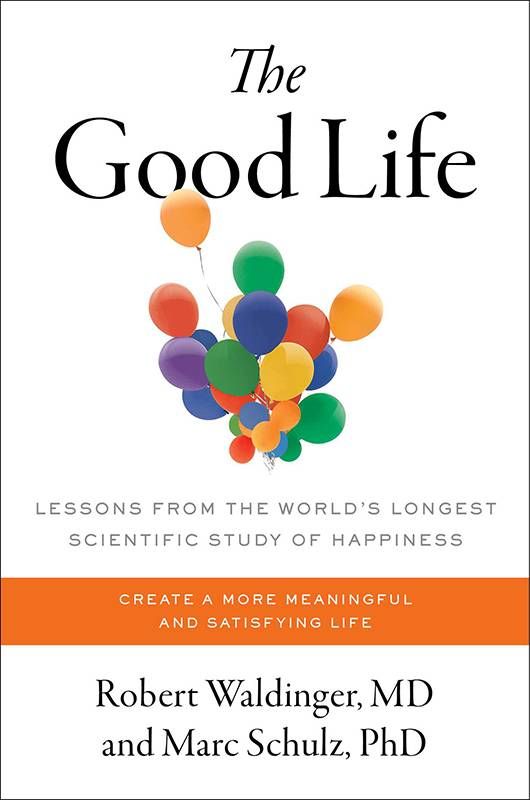Lessons From The World's Longest Study On Happiness
A new book reveals that quality relationships help us live longer, healthier and happier
Back in 1938, the original research participants in a unique study for its time included Harvard University students such as John F. Kennedy, who went on to become the 35th President of the United States and Ben Bradlee, the future editor of the Washington Post, at the helm when it published its Pentagon Papers and Watergate investigative reports.

The study's novel purpose was to analyze what factors contributed to longer, healthier and happier lives by not limiting the questions to strictly physical health but mental and social health, too.
As captured in the new book, "The Good Life - Lessons from the World's Longest Scientific Study of Happiness," co-authors Marc Schulz and Robert Waldinger, associate director and director, respectively, are currently leading the ongoing Harvard Adult Development Study now in its 85th year.
The secret sauce to longevity has less to do with exercise, diet, educational level, the kind of neighborhood you grew up in or how much money you make.
The secret sauce to longevity has less to do with exercise, diet, educational level, the kind of neighborhood you grew up in or how much money you make. Instead, living a longer, better life is primarily based on quality relationships, including a good marriage.
'What Makes a Happier Life?'
With so much focus these days on social determinants of health, increasing social isolation and loneliness with age and exhaustive research in happiness science, this finding doesn't seem surprising.
But over eight decades, by adding different socioeconomic cohorts, women, and even the children of these original men into the blender of "what makes a happier life?" the answer is still the same.
Other longevity trends, including those in biotech, epigenetics, stem cell therapy and immunotherapy, are helping us all live longer, according to Dr. Michael Roizen's book, "The Great Age Reboot – Cracking the Longevity Code for a Younger Tomorrow." During his keynote speech at the What's Next Longevity Innovation Summit in Washington, D.C., Roizen declared, "90 is the new 40."
But is the goal to live longer or to live happier? I interviewed Marc Schulz, an associate professor of psychology at Bryn Mawr University, whose role in the Harvard study and new book included a comprehensive review of longevity research that he and Waldinger conducted to try to answer the question of what creates a life of joy and personal satisfaction.
As contemporary shepherds of the most comprehensive longitudinal study ever done on human life, they have a lot of data that transcend our societal, cultural and ideological differences to show commonality in our basic human needs.
Here are some excerpts from that interview:
Sherri Snelling: Tell me about the surveys and findings over the last 85 years of the Harvard Adult Development Study, especially seen through the lens of our modern age of health science.
Marc Schulz: When the study began, there were 724 young male students at Harvard University, many from privileged backgrounds.
But when teenage boys from Boston's more challenging, impoverished neighborhoods were added – many from immigrant families living in tenements with no running water — and then women, including the wives of our original male cohorts, added in the 1950s and their descendants in more recent years — the pattern emerged that it is about our social fitness, not our physical fitness, pathology or psychology that helps us live longer and happier.
Because these different cohorts cross all gender, culture, religious and socioeconomic boundaries, we felt our findings had great validity. Maybe what was surprising was when we started comparing our data to other longevity and happiness studies from around the world, what emerged across gender, ethnicity, ancestry backgrounds, and, most importantly, across countries essentially was the same result as our study.
"It is relationships that keep us healthier and happier throughout our lifespan."
It is relationships that keep us healthier and happier throughout our lifespan.
I'm fascinated by the term "social fitness." Tell me more about how you define this.
It is remarkable to find relationships are a powerful influencer on health and well-being. We use "social fitness" as a metaphor for physical fitness. It is an excellent reminder that our social connections are as meaningful as our physical health.
It is not to say that healthy habits like moderate exercise, not smoking, and not drinking excessively – those things also matter – but what was surprising was the power of relationships to predict emotional well-being and physical health.
For instance, part of social fitness is optimizing chance encounters. Let's say an older adult goes to the market, and someone asks, "How do you know if this melon is good?" And the older adult can engage in conversation and share experiences and wisdom.
But to do this, we must be present and open to the opportunity to strike up a conversation, or we might learn something from someone we view as being at a different life stage. If we don't pursue physical fitness, our muscles atrophy, and we don't become more robust and flexible.
If we don't tend to our relationships, the same principles apply – our social connections and social skills will wither, so we can't take them for granted, and we need to continue to build them.
"If you invest all your social fitness in just one person, you will be lucky if you can get all your social needs from just one other person."
In the book, you talk about how marrying will increase your longevity and life satisfaction. How does this relate to solo agers or those not married but maybe in partnerships or with "chosen families" and friends in their daily life? And can you also talk about "good" vs. "bad" marriages – how it is the quality of the relationship and not just the status of being married?
Here is a great example: Two men – one a successful lawyer who pursued that career path as well as having a wife and family; the other a teacher who wanted to be a writer but gave up his dream and who also had a wife and family.
You might think the accomplished lawyer was happier because he stayed on the path he planned and succeeded in his career. But the teacher had a loving home life and excellent relationships with his students and was a valued member of his community — he flourished because his connections let him overcome any earlier dreams he did not pursue.
In the lawyer's marriage, he and his wife did not confide in each other what they thought or felt. But in the teacher's marriage, despite disagreements, as spouses, they were each other's confidantes. So it was not just about the marriage for the teacher. His marriage and the quality of the other relationships around him gave him more life satisfaction.
Intimate connections, like marriage, are great resources, but for people who are widowed, divorced or simply solo agers by choice, it is not just the intimate relationships such as marriage that are related to well-being that help us flourish and thrive.
"Relationships can give us so many beautiful things."
In fact, for married people, it is often essential to what relationships they have outside of that marriage that is so critical. Relationships can give us so many beautiful things. It's a magic pill that helps us keep our health and flourish, but it is almost unrealistic that we can expect to get everything from one person, such as a spouse.
Many of us get different things from different people in our social networks – people who bring joy to our lives or help us laugh and have fun. But also people who are good at problem-solving and can help us face challenges in life.
If you invest all your social fitness in just one person, you will be lucky if you can get all your social needs from just one other person.
Since you are also looking at the children of your original participants, most of these adult children are in their 50s and 60s (and their children are in their 20s and 30s); what impact are you seeing in the digital and technology communication tools we have now where we no longer need to be face to face? We lose that oxytocin release from being physically close that bonds us and helps us thrive. Is that impacting our ability to be happy and live longer?
Of the 1,300 descendants we are interviewing, the ages range from 25 – 80, but as you noted, most are in their 50s and 60s. One of the fantastic things about following people across these 85 years is that we recognize that some things are not as different as we think.
For example, new technologies for our original young men born in the 1910s to the 1920s – phones and television – changed the connections they may have had. TV was prophesied to be a significant disruptor and intruder in family life.
So we're looking at the descendants and how much of the digital world was part of their upbringing and how much they were socialized by it or became digital participants later in life. We see that young people today depend on phones for real-time relationship interactions, yet emojis that replace real faces and texts that may not be immediately responded to make it harder to socialize and connect.
In the context of this technological revolution, there is some impact on our ability to regulate emotions in close relationships and the ability to confront challenges and differences of opinion.
It's been made more acute because of things like the pandemic, which meant we may have spent less time with others in real-time in the last three years than we typically do.
But the oxytocin question is a big one, and it is something we're studying through blood tests and other physical exams of our participants.
What surprised you most about the findings in your study?
We weren't surprised that relationships were critical to our happiness and emotional well-being. Working in clinical psychology, we know relationships are essential.
"Sometimes because of serendipity or intention, people can turn around parts of their lives that they are not happy with, and they can thrive in new ways."
What surprised us over the last 20-25 years was the consistent connection between relationships and physical health, and brain health. Relationships get under our skin and affect our bodies.
Through brain scans we now do with our participants, we know relationships also affect our brains in important ways.
We're fortunate in this study because we can trace marital satisfaction across the lifespan. And the U-shaped curve of life satisfaction that other researchers had scientifically examined held that people were happy when they got married but saw a decline as couples had children, with recovery later in life for those that remained married.
When we look at the age of their children, they get a happiness bump when their youngest child turns 18 or the proverbial "leaving the nest."

What is fascinating is that the depth of the U (dissatisfaction) and the large recovery bump can significantly affect the quality of relationships for longevity.
Couples who could reclaim each other and strengthen their relationship, which may have been lost while child-rearing, have benefits that accrued over time; one of the benefits is that they live longer.
What is important for those age 50+ to know about their next few decades based on your research?
People don't stay the same – people change over time which is a story of optimism and hope. One man in the study was lonely for most of his adult life, did not have a fulfilling marriage, and felt alone and depressed in this relationship.
His work was a pleasure, but he struggled with this loss when he retired. He also had health issues, so he was encouraged to join a gym. In addition to improving his physical fitness, he started connecting with friends of all ages at the gym, which he had never had in 60 years of his adult life.
He was an old movies buff, and people at the gym enjoyed listening to his stories and even going to the movie theater with him. This is a story about renewal – he was in his late 60s/early 70s when he found these relationships that continued for the rest of his life.
Lives change more than we think they change, and sometimes because of serendipity or intention, people can turn around parts of their lives that they are not happy with, and they can thrive in new ways.
Our original 724 study participants have taught us that no matter what our lot is, we can blossom, and happiness can begin at any age.
To hear more of Sherri's interview with Marc Schulz, listen to the "Caregiving Club On Air" podcast, Season 3, Episode 20.

Sherri Snelling is a corporate gerontologist, speaker, and consultant in aging and caregiving. She is the author of “Me Time Monday – The Weekly Wellness Plan to Find Balance and Joy for a Busy Life” and host of the "Caregiving Club On Air" podcast. Read More

